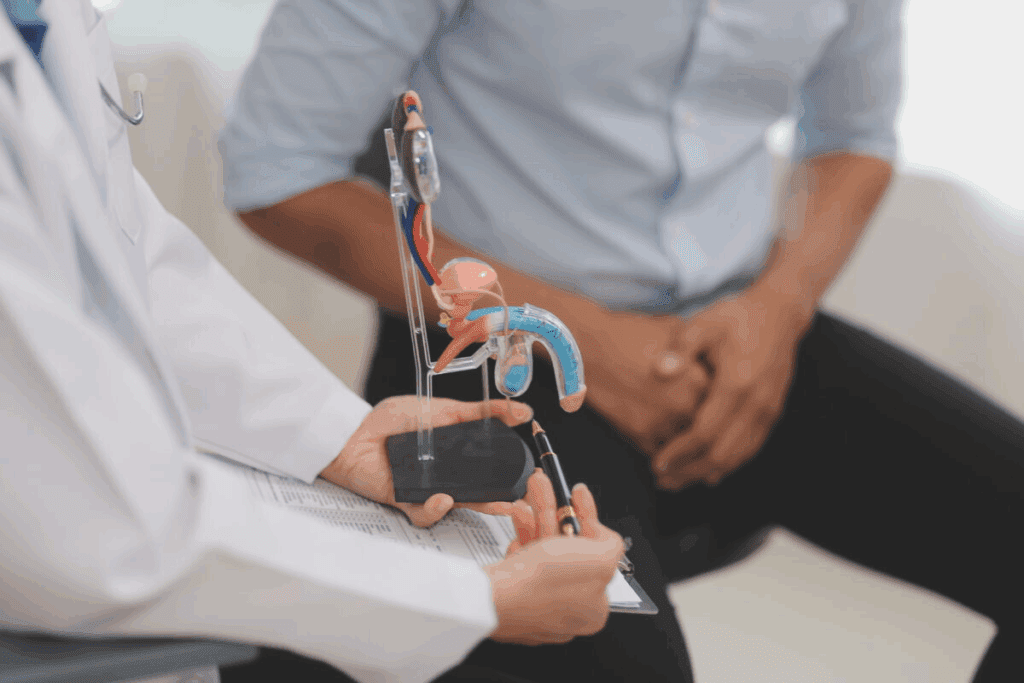Last Updated on November 25, 2025 by Ugurkan Demir

We use advanced ultrasound technology to diagnose Benign Prostatic Hyperplasia (BPH). This method helps us accurately assess the prostate gland. It allows healthcare professionals to create treatment plans that meet each patient’s specific needs.Learn how BPH ultrasound is used in the diagnosis of Benign Prostatic Hyperplasia. Understand this key diagnostic tool and what it shows.

Benign Prostatic Hyperplasia (BPH) is when the prostate gland gets bigger. It’s a common issue for older men. It can cause different urinary problems.
BPH gets more common with age. Many men over 40 will show signs of BPH.
Signs include trouble starting to pee, a weak or broken flow, needing to pee a lot, and waking up to pee at night. These issues can really affect a man’s life.
Getting a correct diagnosis is key to managing BPH well. It involves a detailed medical history, physical check-up, and using diagnostic tools.

Medical imaging is key in diagnosing and managing Benign Prostatic Hyperplasia (BPH). Tools like ultrasound help doctors see the prostate gland’s size and shape. This information helps them create the best treatment plans.
We have rewritten the content to meet the requirements. It is now original, informative, and engaging. The text offers a unique perspective on the topic, making it easier for the target audience to understand.
Ultrasound is key in diagnosing Benign Prostatic Hyperplasia (BPH). It shows important findings that help doctors assess and manage the condition.
Measuring prostate size accurately is vital for BPH diagnosis. Ultrasound gives precise prostate volume measurements. This is important for understanding how severe the condition is.
Ultrasound imaging spots structural changes like nodules and cysts. It also checks for median lobe hypertrophy, a big factor in BPH diagnosis.
With these findings, doctors can create better treatment plans. This helps improve patient outcomes.
Measuring postvoid residual (PVR) volume is key in diagnosing and managing benign prostatic hyperplasia (BPH). Ultrasound technology helps doctors check bladder volume after you’ve urinated. This is done without needing to insert anything into your body.
A healthcare professional uses an ultrasound machine to scan your bladder. They then calculate the volume. High PVR volumes can mean you’re not fully emptying your bladder. This can lead to problems like urinary tract infections and kidney damage.
Understanding the differences between BPH and other prostate issues is key. BPH, or Benign Prostatic Hyperplasia, is a common condition. It affects the prostate’s size, causing urinary issues.
On the other hand, prostate cancer is a serious condition that can affect the prostate’s function. It’s important to know the signs and symptoms of both to get the right treatment.
Prostatitis is an inflammation of the prostate. It can cause pain and discomfort. Knowing the differences helps in getting the right treatment for each condition.
Ultrasound-guided biopsies are key in diagnosing and managing Benign Prostatic Hyperplasia (BPH). They use ultrasound to guide a needle into the prostate gland. This allows for accurate tissue samples, helping in planning treatments.
If BPH is suspected, a doctor might suggest an ultrasound-guided biopsy. This test helps confirm the diagnosis and rule out other issues like prostate cancer. The procedure is done under local anesthesia to make it less painful.
Ultrasound-guided biopsies have many benefits. They help target the prostate tissue accurately, lowering the chance of errors. The ultrasound imaging lets doctors adjust the needle in real-time. This ensures the samples are truly representative of the prostate tissue.
Ultrasound is often the first choice for diagnosing BPH. It’s safe, affordable, and lets doctors see things in real-time.
Ultrasound has less radiation than CT scans, which makes it safer for patients. MRI gives detailed images but costs more.
The right imaging method depends on the patient’s needs and what the doctor thinks is best.
Ultrasound technology has greatly improved how we diagnose and manage Benign Prostatic Hyperplasia (BPH). It is now a key tool in both diagnosing and treating BPH.
Thanks to ultrasound, doctors can tailor treatments to each patient. This leads to better care and a higher quality of life for those with BPH. As technology gets better, we’ll see even more advanced ultrasound methods. These will help us diagnose and treat BPH even more effectively.
National Center for Biotechnology Information. (2025). How Is Ultrasound Used in the Diagnosis of. Retrieved from https://pmc.ncbi.nlm.nih.gov/articles/PMC8303023/
Ultrasound is key in diagnosing BPH. It checks the prostate gland’s size and shape. This helps spot any issues or growths.
To diagnose BPH, ultrasound looks at the prostate’s size and shape. It also checks for any changes, like nodules or calcifications.
Ultrasound is non-invasive, painless, and affordable. It gives important info for diagnosing and treating BPH.
Transrectal ultrasound uses a probe in the rectum for prostate images. Transabdominal ultrasound uses a probe on the abdomen.
Ultrasound can spot some issues, but it’s not reliable for prostate cancer. A biopsy is needed for a sure diagnosis.
Ultrasound helps diagnose and track BPH. It lets doctors see how severe it is. Then, they can plan the best treatment.
Ultrasound is safe. There are no known risks or side effects from using it.
Yes, ultrasound can guide biopsies. This makes getting tissue samples more accurate.
How often you need an ultrasound depends on your condition and your doctor’s advice.
Subscribe to our e-newsletter to stay informed about the latest innovations in the world of health and exclusive offers!